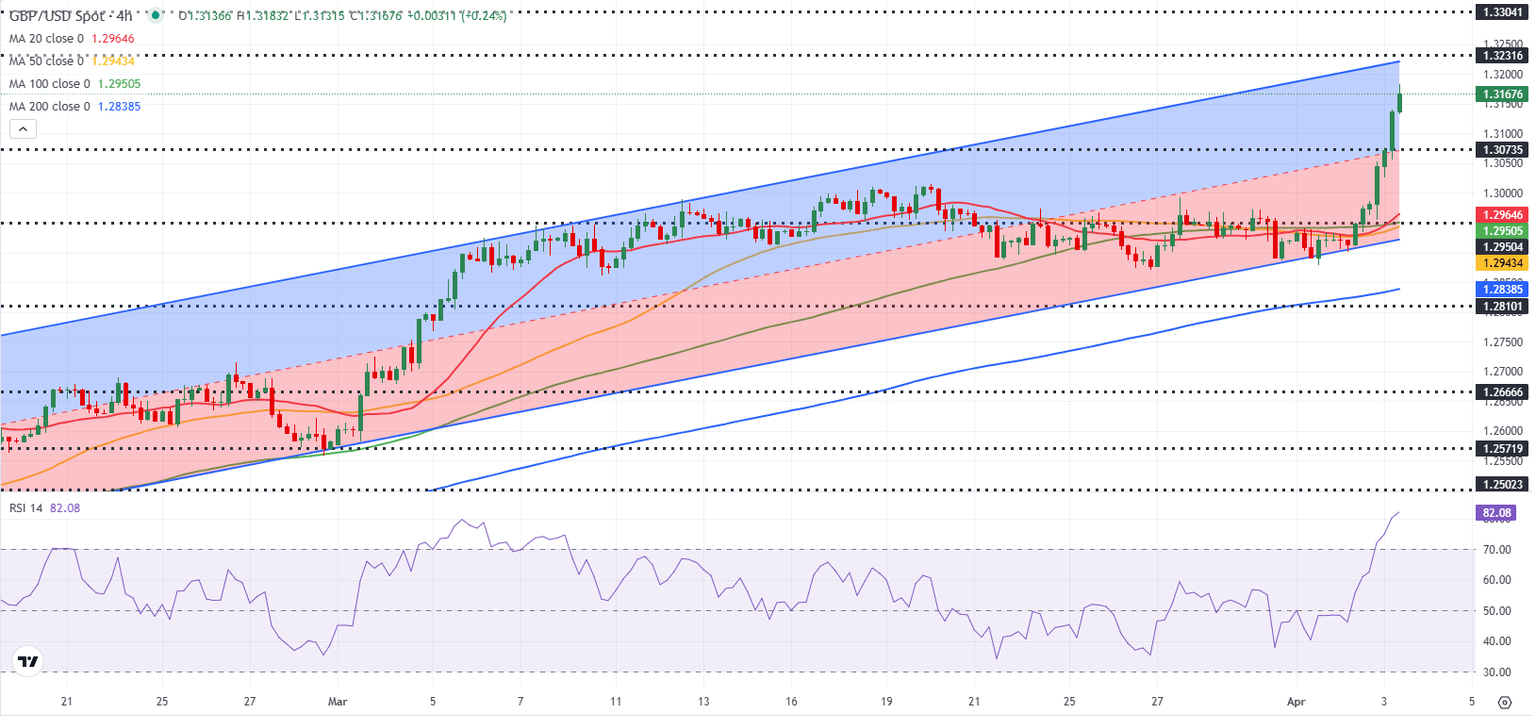GBP/USD Forecast: Pound Sterling shows no signs of slowing down despite overbought conditions
- GBP/USD climbs toward 1.3200 in the European session on Thursday.
- The US Dollar (USD) remains under strong selling pressure after tariff announcements.
- The technical outlook highlights extremely overbought conditions in the short term.

GBP/USD rallies higher in the European session on Thursday and trades at its strongest level in six months above 1.3150. Buyers could ignore overbought conditions in the near term and position themselves for an extended rally, while the US Dollar (USD) remains under heavy selling pressure.
British Pound PRICE Today
The table below shows the percentage change of British Pound (GBP) against listed major currencies today. British Pound was the strongest against the US Dollar.
| USD | EUR | GBP | JPY | CAD | AUD | NZD | CHF | |
|---|---|---|---|---|---|---|---|---|
| USD | -1.61% | -0.98% | -1.88% | -0.58% | -0.66% | -0.96% | -1.96% | |
| EUR | 1.61% | 0.38% | -0.27% | 1.08% | 0.98% | 0.68% | -0.35% | |
| GBP | 0.98% | -0.38% | -0.66% | 0.69% | 0.62% | 0.31% | -0.75% | |
| JPY | 1.88% | 0.27% | 0.66% | 1.31% | 1.25% | 0.80% | -0.11% | |
| CAD | 0.58% | -1.08% | -0.69% | -1.31% | 0.00% | -0.39% | -1.43% | |
| AUD | 0.66% | -0.98% | -0.62% | -1.25% | -0.01% | -0.31% | -1.34% | |
| NZD | 0.96% | -0.68% | -0.31% | -0.80% | 0.39% | 0.31% | -1.05% | |
| CHF | 1.96% | 0.35% | 0.75% | 0.11% | 1.43% | 1.34% | 1.05% |
The heat map shows percentage changes of major currencies against each other. The base currency is picked from the left column, while the quote currency is picked from the top row. For example, if you pick the British Pound from the left column and move along the horizontal line to the US Dollar, the percentage change displayed in the box will represent GBP (base)/USD (quote).
US President Donald Trump announced that they will impose a 10% baseline tariff, effective April 5, on all imports to the US. United Kingdom will be among the countries that will only face this base rate. Additionally, the Trump administration confirmed that they will impose 25% tariffs on all foreign-made automobiles.
British business minister Jonathan Reynolds said on Thursday that they will not rethink their fiscal rules because of US tariffs and argued that they should ignore those who say that they should trigger a bigger trade war.
The USD weakens sharply against its peers as investors fear that the new US trade regime will trigger a downturn in the economy. Meanwhile, the probability of a 25 basis points (bps) Federal Reserve rate cut in May climbed above 20% from 10% before the tariff announcements.
In the second half of the day, the US Department of Labor will publish weekly Initial Jobless Claims data. The ISM Services Purchasing Managers Index (PMI) data will also be featured in the US economic calendar. In case these data come in much better than expected, the USD could find support in the near term and cap GBP/USD's upside. Nevertheless, investors are likely to refrain from betting on a steady USD recovery in the near term.
GBP/USD Technical Analysis

The Relative Strength Index (RSI) indicator on the 4-hour chart rose above 80, pointing to extremely overbought conditions for GBP/USD in the near term.
On the upside, 1.3200 (static level, round level) aligns as interim resistance before 1.3230 (upper limit of the ascending regression channel) and 1.3300 (static level, round level).
Looking south, supports could be spotted at 1.3100 (static level, round level), 1.3070 (mid-point of the ascending channel) and 1.3000 (static level, round level).
Pound Sterling FAQs
The Pound Sterling (GBP) is the oldest currency in the world (886 AD) and the official currency of the United Kingdom. It is the fourth most traded unit for foreign exchange (FX) in the world, accounting for 12% of all transactions, averaging $630 billion a day, according to 2022 data. Its key trading pairs are GBP/USD, also known as ‘Cable’, which accounts for 11% of FX, GBP/JPY, or the ‘Dragon’ as it is known by traders (3%), and EUR/GBP (2%). The Pound Sterling is issued by the Bank of England (BoE).
The single most important factor influencing the value of the Pound Sterling is monetary policy decided by the Bank of England. The BoE bases its decisions on whether it has achieved its primary goal of “price stability” – a steady inflation rate of around 2%. Its primary tool for achieving this is the adjustment of interest rates. When inflation is too high, the BoE will try to rein it in by raising interest rates, making it more expensive for people and businesses to access credit. This is generally positive for GBP, as higher interest rates make the UK a more attractive place for global investors to park their money. When inflation falls too low it is a sign economic growth is slowing. In this scenario, the BoE will consider lowering interest rates to cheapen credit so businesses will borrow more to invest in growth-generating projects.
Data releases gauge the health of the economy and can impact the value of the Pound Sterling. Indicators such as GDP, Manufacturing and Services PMIs, and employment can all influence the direction of the GBP. A strong economy is good for Sterling. Not only does it attract more foreign investment but it may encourage the BoE to put up interest rates, which will directly strengthen GBP. Otherwise, if economic data is weak, the Pound Sterling is likely to fall.
Another significant data release for the Pound Sterling is the Trade Balance. This indicator measures the difference between what a country earns from its exports and what it spends on imports over a given period. If a country produces highly sought-after exports, its currency will benefit purely from the extra demand created from foreign buyers seeking to purchase these goods. Therefore, a positive net Trade Balance strengthens a currency and vice versa for a negative balance.
Premium
You have reached your limit of 3 free articles for this month.
Start your subscription and get access to all our original articles.
Author

Eren Sengezer
FXStreet
As an economist at heart, Eren Sengezer specializes in the assessment of the short-term and long-term impacts of macroeconomic data, central bank policies and political developments on financial assets.

















